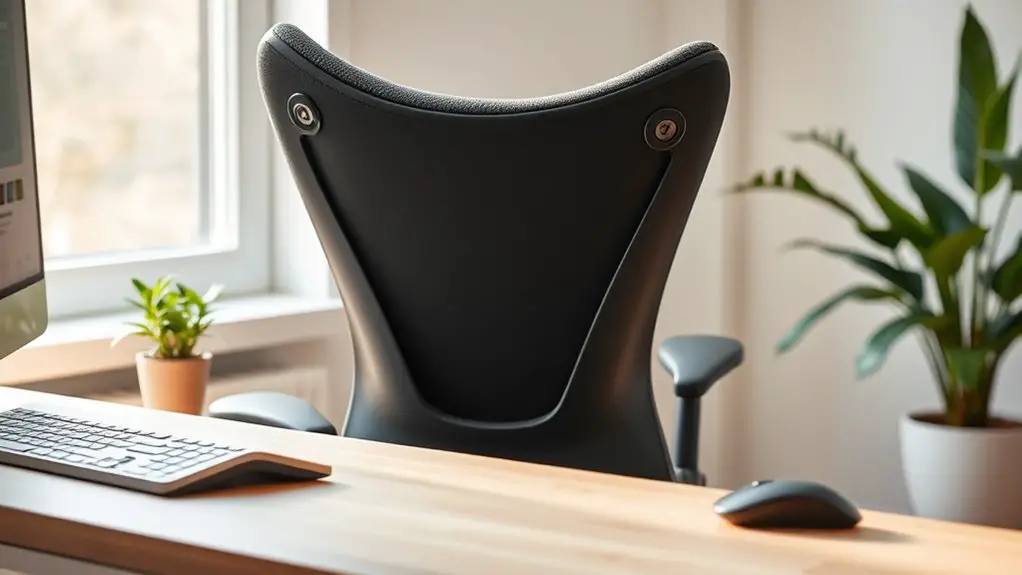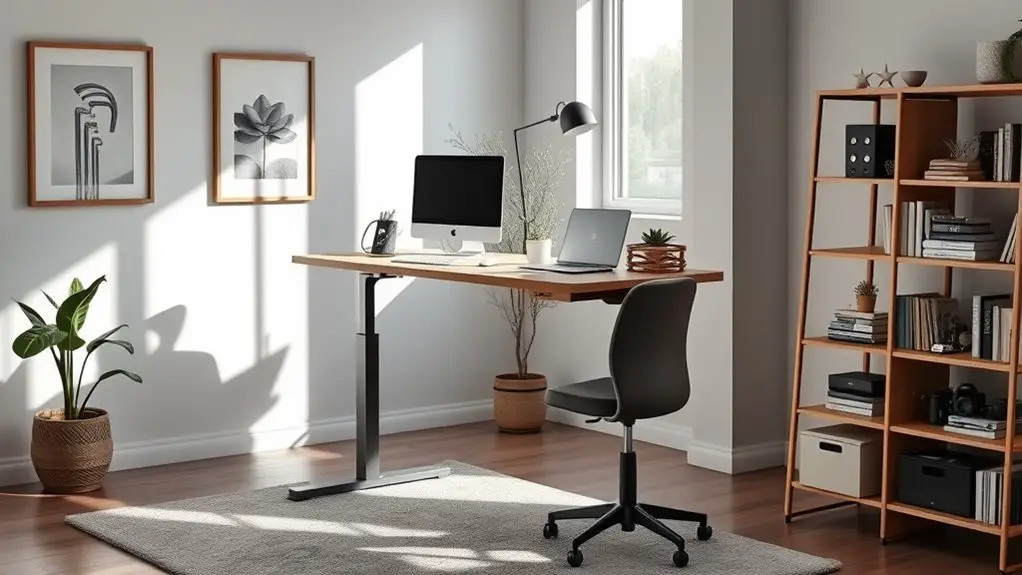To create the ultimate ergonomic home office setup, prioritize chair and desk height for proper posture, ensuring your feet are flat and arms at a 90-degree angle. Position your monitor at eye level and within arm's reach to avoid strain. Keep your keyboard and mouse close to reduce discomfort. Don't underestimate the importance of good lighting and wrist support. Following these guidelines can markedly boost your comfort and productivity. Discover even more effective tips to enhance your workspace.
Table of Contents
Key Takeaways
- Select an ergonomic chair that supports your spine's natural curve and allows for proper height adjustments for comfort and posture.
- Position your monitor at eye level and an arm's length away to minimize neck strain and improve visibility.
- Use a keyboard and mouse that are at the same height, ensuring your arms remain relaxed and wrists are in a neutral position.
- Incorporate wrist supports and ergonomic accessories to reduce strain during prolonged computer use and enhance typing efficiency.
- Ensure adequate lighting and a clutter-free workspace to promote focus, reduce glare, and create a comfortable working environment.
Chair Ergonomics

When it comes to creating a comfortable and productive home office, chair ergonomics play an essential role in your daily experience.
An ergonomic chair supports your spine's natural curve, preventing slouching and strain. You should adjust the height so your feet are flat on the floor and your knees are bent at 90 degrees.
Proper armrests reduce upper body tension, allowing your shoulders to relax. The seat should support your thighs without cutting into them, promoting healthy blood flow. Ergonomic chairs are specifically designed to accommodate various body types and preferences, ensuring maximum comfort during long working hours.
Look for breathable materials that enhance comfort and durability. Investing in a chair with customizable lumbar support and multiple adjustment points guarantees you find the perfect fit for your body, ultimately improving your posture and productivity.
Desk Setup
Creating an ergonomic desk setup is essential for maximizing comfort and productivity in your home office.
Start by adjusting your desk height to align with your elbows when your arms are at a 90-degree angle, typically between 28 to 30 inches. Confirm there's enough space under the desk for your legs and feet to move freely.
Adjust your desk height to ensure your elbows are at a 90-degree angle, allowing for comfortable movement beneath the desk.
Keep frequently used items within arm's reach to minimize stretching, and use storage solutions to maintain a clutter-free environment. Incorporate ergonomic accessories like wrist supports and footrests to enhance comfort. Incorporating movement into the workspace is crucial for preventing discomfort and promoting health, so consider standing desks for variety.
Regularly assess your workspace to make necessary adjustments, and consider standing desks for variety.
With these tips, you'll create a functional desk setup that promotes wellness and efficiency.
Monitor Placement

To create a comfortable workspace, you should position your monitor at an arm's length away and align its top with your eye level. This setup not only reduces glare but also minimizes neck strain, allowing for a more natural viewing angle. Additionally, maintaining an ergonomic workspace can significantly enhance your overall comfort and well-being during long hours of work.
Optimal Monitor Distance
Finding the ideal monitor distance is essential for maintaining comfort and reducing eye strain while working from home. You should aim for a distance of 20 to 40 inches (50 to 100 cm) from your eyes to the screen. This range keeps you comfortable without needing to lean forward or backward. If you have a 24-inch or 27-inch monitor, try to stay within 20 to 30 inches (50 to 75 cm). Placing your monitor at about arm's length helps maintain good posture and minimizes excessive head movement. Proper screen distance is crucial to reducing the risk of eye discomfort issues such as red eyes and eye fatigue.
Eye Level Alignment
Achieving proper eye level alignment when positioning your monitor is essential for your comfort and overall well-being while working from home.
To maintain a neutral posture and prevent strain, follow these key guidelines:
- Make certain the top of your monitor is at or slightly below eye level.
- Position the center of the screen 15-20 degrees below horizontal eye level for best viewing.
- Keep the monitor directly in front of you to avoid twisting your neck.
Additionally, optimal screen height should ensure that your eyes align with a point 2-3 inches below the monitor's top for enhanced comfort.
Reduce Glare Effects
Glare can be a considerable distraction when working at your monitor, impacting both comfort and productivity. To reduce glare, position your monitor at a comfortable angle, ideally tilting it back 10 to 20 degrees to minimize direct light reflections.
Keep it away from direct lighting sources and windows; placing it at a right angle to windows can help considerably. Use task lighting instead of harsh overhead lights and consider glare filters or anti-glare screens for improved visibility. Additionally, ensure your monitor is set up at eye level to promote better posture and reduce strain.
Regularly clean your screen to eliminate dust and smudges, and adjust brightness and contrast settings as needed. Additionally, utilize curtains or blinds to manage natural light, ensuring your workspace remains glare-free and conducive to focus.
Keyboard and Mouse Ergonomics

When it comes to keyboard and mouse ergonomics, proper positioning is key for your comfort and productivity. You should place your keyboard directly in front of you and keep your mouse close to prevent straining your arms. Additionally, maintaining proper keyboard height is crucial for ensuring that your arms are at a comfortable 90° bend while typing. Don't forget to take into account wrist support; it plays an essential role in reducing discomfort during long work sessions.
Keyboard Positioning Techniques
An effective keyboard positioning technique is essential for maintaining comfort and preventing strain during long hours at your home office. Here are some key principles to keep in mind:
- Height Adjustment: Your keyboard should be at or slightly below elbow level to avoid wrist strain.
- Angle and Tilt: Position your keyboard flat or slightly tilted away to maintain a neutral wrist posture.
- Distance and Reach: Keep the keyboard directly in front of you, ensuring it's within easy reach to prevent leaning forward. Additionally, maintaining a central positioning of your mouse and keyboard can help ensure natural shoulder alignment and reduce strain.
Consider using a padded wrist rest for additional support and make sure your chair and desk height are adjusted for ideal ergonomic positioning.
These adjustments can greatly enhance your comfort and productivity while typing.
Mouse Placement Tips
Proper mouse placement is essential for a comfortable and efficient workspace. Position your mouse next to your keyboard to avoid unnecessary stretching, which can lead to strain.
Make sure both the mouse and keyboard are at the same height to keep your arms relaxed. This alignment supports your body's natural posture and reduces the risk of musculoskeletal injuries. Additionally, it's important to assess your workspace for proper assessment of workspace to ensure comfort and accessibility.
If space is tight, consider using a compact keyboard or a mouse platform to bring the mouse closer to your body. Avoid excessive reaching by keeping the mouse within easy reach, enhancing your overall productivity.
Opt for ergonomic accessories like vertical mice, as they promote a neutral wrist position, further minimizing discomfort during prolonged use.
Wrist Support Importance
Wrist support is vital for maintaining comfort and preventing injuries during long hours at your keyboard and mouse. A good wrist rest helps keep your wrists in a neutral position, reducing strain and the risk of conditions like carpal tunnel syndrome.
- Improves hand posture: Supports natural alignment for better typing efficiency.
- Enhances comfort: Soft materials like gel or foam cushion your wrists, making long sessions more bearable. Additionally, ergonomic tools align gaming equipment with natural body movements, reducing strain and discomfort during prolonged gaming.
- Prevents injuries: Regular use can considerably lower the chance of repetitive strain injuries.
Choosing the right wrist rest is essential; it should fit your keyboard and promote proper alignment.
Lighting and Environment
While creating an ergonomic home office, lighting plays a crucial role in enhancing both comfort and productivity. Natural light is your best friend; it boosts your mood and reduces electricity bills. Position your desk to maximize sunlight while avoiding screen glare. If you can, add a window with a view to lift your spirits. Additionally, good home office lighting is essential for effective workspace design alongside furniture and equipment.
Task lighting is essential for focused work areas. Use adjustable desk lamps to customize light intensity and angle, reducing eye strain.
Don't forget ambient lighting, which softens harsh task lights and creates a cozy atmosphere. Aim for a balance that complements your workspace.
Health and Movement
Creating an ergonomic home office isn't just about comfort; it also greatly impacts your health and movement. By prioritizing ergonomics, you can notably reduce the risk of injuries and enhance your overall well-being.
- Reduces the risk of injury: Proper posture minimizes strain and discomfort. Additionally, maintaining good posture can significantly reduce the likelihood of back and neck pain.
- Encourages active workstyle: Standing desks promote regular movement, benefiting circulation.
- Boosts mood and focus: Alternating positions can elevate energy levels and reduce stress.
Incorporating these elements into your workspace supports better posture, enhances productivity, and fosters mental well-being.
Frequently Asked Questions
How Often Should I Take Breaks During Work Hours?
You should take breaks every 90 minutes to boost your productivity. Aim for two short 15-minute breaks daily, and don't forget about microbreaks lasting around 40 seconds to maintain your focus and well-being.
What Are the Signs of Poor Ergonomic Setup?
You'll notice signs of poor ergonomic setup if you experience persistent pain, numbness, or chronic fatigue. Difficulty concentrating and decreased productivity often indicate your workspace needs adjustments to improve comfort and efficiency.
Can I Use a Standing Desk Instead?
Yes, you can use a standing desk instead. It promotes better posture, boosts energy, and improves circulation. Just verify it's adjustable for your height and that you gradually shift to standing for comfort.
How Can I Improve My Posture While Sitting?
To improve your posture while sitting, adjust your chair for lumbar support, keep your feet flat on the floor, and guarantee your monitor's top line is at eye level. Regularly check and correct your alignment.
What Accessories Can Enhance My Ergonomic Workspace?
To enhance your ergonomic workspace, consider adding monitor arms, a standing desk, keyboard trays, and ergonomic chairs. These accessories promote better posture, reduce strain, and keep your workspace organized, ultimately boosting your comfort and productivity.



